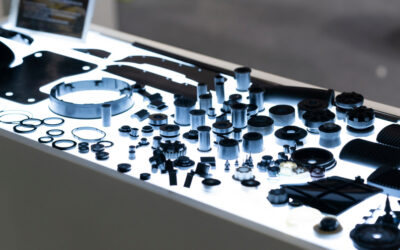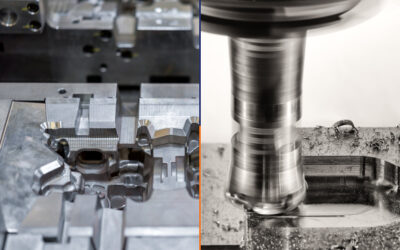A bead blast is a process that uses tiny beads to smooth and polish the surface of a material. After CNC machining, bead blasting is the final finishing process that gives a part its desired finish.
In this comprehensive guide, we’ll answer all your questions about bead blasting, including what it is, how it works, the pros and cons, tips, and more.
What Is Bead Blasting?
Bead blasting is a process in which small spheres of glass or other abrasive material are blasted at high pressure against a surface. Bead blasting is commonly used as a finishing step in manufacturing metal parts or to remove rust, paint, or other debris from metal surfaces. It can also be used to texturize plastic or glass surfaces.
How Does a Bead Blast Work?
First, the surface to be bead blasted is placed in a chamber. The chamber is then sealed and pressurized with air. The abrasive material is fed into the chamber through a nozzle, and the blast of abrasive particles strikes the surface of the workpiece.
The force of the blast removes debris or contaminants from the surface of the workpiece and smooths or polishes the surface.
Bead blasting can create a variety of different finishes, from a matte finish to a highly polished finish. The type of finish achieved depends on the size and type of abrasive particles used, as well as the pressure of the air stream.
Equipment Used for a Bead Blast Finish
To create a bead blast finish, special equipment is required. This includes abrasive media, a blaster nozzle, gloves, and a blast cabinet.
Bead Blaster Cabinet
The blaster cabinet is used as a containment system for the bead blasting process. Bead blasting cabinets come in a variety of sizes, from small tabletop units to large industrial-sized units. The cabinet has a viewing window so the operator can see the work being done.
Bead blaster cabinets are also much quieter than traditional sandblasting equipment, making them ideal for use in areas where noise levels need to be kept low.
It’s essential that the bead blaster cabinet is high-quality and durable. Otherwise, it will not be able to contain the high-pressure air and abrasive material. The seams of the cabinet must also be sealed correctly, so it doesn’t leak. If allowed to escape, the dust from the bead blasting process can harm the operator’s health.
Bead Blaster Gun
The bead blaster gun is the device that propels the abrasive media at high pressure against the surface of the workpiece.
Bead blaster guns are available in both handheld and benchtop models. Handheld models are typically smaller and more portable, while benchtop models are larger and more powerful. Both types of bead blaster guns use compressed air to operate. When selecting a bead blaster gun, it is important to choose one that is sized appropriately for the task at hand.
Either a trigger or a pedal is used to operate the bead blaster gun. When the trigger or pedal is depressed, compressed air is released from the tank and travels through the hose to the gun. The air then passes through a nozzle at the end of the gun, which propels the abrasive media towards the surface of the workpiece.
The pedal is the better option for longer blasting sessions as it will allow the operator to keep a constant flow of abrasive media without tiring their hand.
A blast nozzle is attached to the bead blaster gun and is used to control the direction of the abrasive stream. The nozzle can be rotated so the operator can direct the stream of abrasive particles at different angles. Bead blaster nozzles come in a variety of shapes and sizes.
Gloves
Suitable gloves are another essential piece of equipment for the bead blasting process. Connected to the cabinet, a pair of high-quality gloves provide a firm grip on the bead blaster gun.
Abrasive Bead Blaster Media
Abrasive media is the term used for the small spheres of glass or other materials that are blasted at high pressure against a surface. Many different types of media can be used, including aluminum oxide, silicon carbide, glass beads, and more.
The type of media used will determine the type of finish achieved. For example, using larger spheres of media will create a rougher finish, while smaller spheres will create a smoother finish.
Some media are better suited for certain applications than others. For example, if you’re trying to remove rust from a metal surface, you would use a different type of media than if you’re trying to polish a plastic surface.
Glass beads are available in various sizes.
The most common dimensions are
- 40-60
- 60-100
- 100-170
- 170-325
Pros and Cons of Bead Blast Finishing
There are both advantages and disadvantages to using bead blast finishing.
Pros
- Environmentally friendly – The bead blasting method can be environmentally friendly as many glass beads are made from materials that don’t contaminate the water supply. Glass beads can also be reused up to 30 times, producing less waste.
- Precise – The operator has a high degree of control over the bead blaster gun, so they can easily achieve consistent results.
- Safe – Bead blasting is a relatively safe process as there is no contact between the operator and the workpiece. There is also no heat generated during the process.
- Delicate – Bead blasting is a good option for sensitive workpieces as it won’t damage the surface.
Cons
- Can be time-consuming – Bead blasting can be a time-consuming process, especially if a large surface area needs to be covered.
- Requires specialized equipment – To bead blast properly, you need access to specialized equipment. Bead blasting cabinets and equipment can be expensive to purchase outright. However, many companies offer rental options that make the process more affordable.
Bead Blasting Compared to Other Finishing Methods
Bead blasting and sandblasting are the two most popular methods for stripping paint and other materials from surfaces. Both processes use high-pressure air to blast away surface contaminants, but there are some key differences between the two.
As we have discussed, bead blasting is typically done with glass beads, which are less abrasive than sand particles. This makes bead blasting ideal for delicate surfaces like car body panels and engine parts. Bead blasting can also be used to create a matte finish on surfaces that will be painted or powder coated.
Sandblasting, on the other hand, is a more aggressive process that is better suited for removing thick layers of paint or rust. But the end result is a rougher finish than what can be achieved with bead blasting.
What Are Bead Blasting’s Applications?
Bead blasting has a wide range of applications in different industries. Here are some of the most common uses for bead blasting:
- Peening – used to relieve stress in metal components
- Deburring – used to remove sharp edges from machined parts
- Cleaning – used to remove contaminants such as rust, paint, and oil from surfaces
- Finishing – used to create a matte finish on surfaces
- Polishing – used to create a shine on metal surfaces
Bead Blasting Tips for the Best Finish
If you are just starting out on your bead blasting journey, here are a few best practices to achieve the best finish:
- Use low pressure – This will help to prevent any damage to the surface of your workpiece.
- Use the right media – As mentioned earlier, different media will create different finishes. Use smaller beads for a smoother finish and larger beads for a rougher finish.
- Don’t forget about safety – Always wear gloves, eye protection, and a respirator when bead blasting.
- Start with a small area – When you’re first starting out, it’s best to practice on a small area. This will help you get a feel for the bead blaster and how it works before moving on to larger areas.
In Summary
Hopefully, you now have a basic understanding of what bead blasting is and how it works. This versatile finishing method can be used for various applications and is one of the best methods for delicate surfaces.
At Gensun, we offer a wide range of Surface finishing services; contact us to discuss your project if you have any questions or require a quote.
Bead Blasting FAQs
Is bead blasting safe?
Yes, as the process is carried out in a closed cabinet, there is no exposure to fumes or dust. The gloves used will also protect your hands. Take the necessary safety precautions as you would working with any other high-pressure equipment.
How long does bead blasting take?
The length of time it takes to bead blast a surface depends on the size of the surface and the desired finish. A small surface may only take a few minutes, while a larger surface may take several hours.
Can you bead blast aluminum?
Yes, bead blasting can be used on aluminum surfaces. Aluminum parts that require a dull finish are typically bead blasted.
Is it better to bead blast or sandblast?
Both have their places; sandblasting is the more aggresive of the two and is better for stripping paint or rust, while bead blasting is a gentler method making it a good match for more sensitive workpieces.



